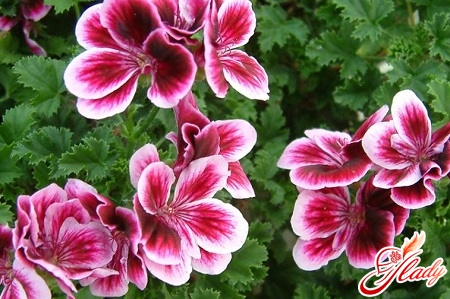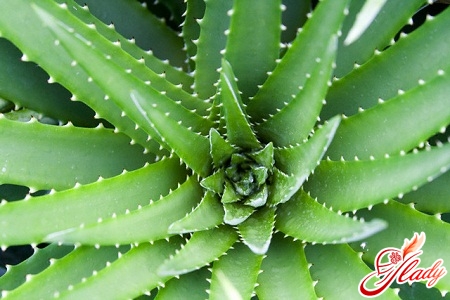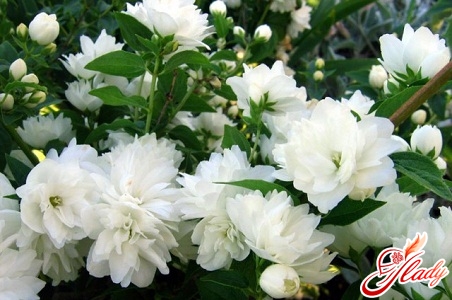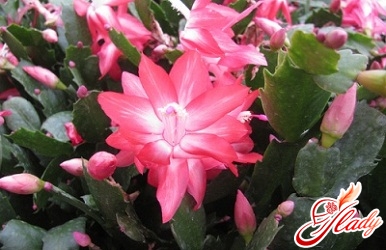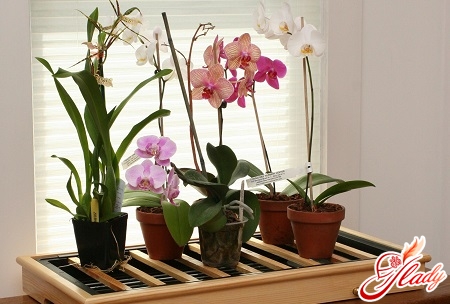 Different types of indoor orchids have long been fond offlower growers. It is difficult to find a plant that could as well as this princess of the tropics, decorate a home greenhouse. Indeed, a slender stem with juicy-green leaves and unbelievable blooming buds will surely make you admire your harmonious combination more than once. But those of you who decided to buy an orchid in a pot, you need to know that now on your windowsill settled quite a demanding guest, waiting for the owner of special care. You will have to provide it with a suitable primer, the proper amount of light, moisturizing and watering, and fertilizing with fertilizers. Do not forget about the transplant, which will require an overgrown plant. All these conditions indicate a difficult and time-consuming care, but it is necessary if you want the orchid to please you with regular flowering, and not just grow green shy modesty. But first of all you have to understand how to choose and where to buy this tropical beauty, because with orchids the situation is not so simple. It is better not to buy a plant in a supermarket, but in a small private greenhouse. It is there that you will most likely be sold a healthy orchid, which received all the required care from the beginning of growth and to the flowering period, and not the drooping female tribeswoman with sluggish leaves and falling petals. In any case, pay attention to the condition of the roots. They should be elastic and have a slightly whitish or light green hue. Make sure that there are no signs of rot on the visible part of the root system. It is very convenient in this way to choose orchids that grow without a substrate. Their roots are open, and wicker baskets serve as pots. And care for this kind of exercise is easier, because you can always understand, it's time to water it or not yet. But in any other case it is enough just to show care, in order to avoid trouble with the purchase of a poor-quality plant. Let's say you have already made your choice and brought this blossoming charm home. Now you have to master all the subtleties of coexistence with a capricious "tropic". It is important to understand how to care for an orchid in a pot, so that she was well and comfortable, and you could enjoy the beauty and tenderness of blossoming buds. This article contains a number of general recommendations for creating optimal conditions for plants of the species described.
Different types of indoor orchids have long been fond offlower growers. It is difficult to find a plant that could as well as this princess of the tropics, decorate a home greenhouse. Indeed, a slender stem with juicy-green leaves and unbelievable blooming buds will surely make you admire your harmonious combination more than once. But those of you who decided to buy an orchid in a pot, you need to know that now on your windowsill settled quite a demanding guest, waiting for the owner of special care. You will have to provide it with a suitable primer, the proper amount of light, moisturizing and watering, and fertilizing with fertilizers. Do not forget about the transplant, which will require an overgrown plant. All these conditions indicate a difficult and time-consuming care, but it is necessary if you want the orchid to please you with regular flowering, and not just grow green shy modesty. But first of all you have to understand how to choose and where to buy this tropical beauty, because with orchids the situation is not so simple. It is better not to buy a plant in a supermarket, but in a small private greenhouse. It is there that you will most likely be sold a healthy orchid, which received all the required care from the beginning of growth and to the flowering period, and not the drooping female tribeswoman with sluggish leaves and falling petals. In any case, pay attention to the condition of the roots. They should be elastic and have a slightly whitish or light green hue. Make sure that there are no signs of rot on the visible part of the root system. It is very convenient in this way to choose orchids that grow without a substrate. Their roots are open, and wicker baskets serve as pots. And care for this kind of exercise is easier, because you can always understand, it's time to water it or not yet. But in any other case it is enough just to show care, in order to avoid trouble with the purchase of a poor-quality plant. Let's say you have already made your choice and brought this blossoming charm home. Now you have to master all the subtleties of coexistence with a capricious "tropic". It is important to understand how to care for an orchid in a pot, so that she was well and comfortable, and you could enjoy the beauty and tenderness of blossoming buds. This article contains a number of general recommendations for creating optimal conditions for plants of the species described.
Lighting and watering of orchids growing in pots
First of all, the regular formation of budsyou need a long light day - it should be at least twelve to fourteen hours. Each kind of orchid has its own requirements for lighting, but in most cases it is necessary to avoid direct sunlight, that is, the light must be scattered and come in large quantities. Only one room beauty can withstand the quite aggressive conditions from this point of view - orchid vanda. But even in hot weather it is worth while to shade. Without this, proper care is impossible. But phalaenopsis just does not like the excess of bright rays. In order not to lose and make life easier for yourself and the plant, settle it on the window, which for a long time is within the reach of the sun, but also allows you to luxuriate in a diffused light. It is possible to judge whether the care for the orchid is carried out correctly in terms of providing it with a suitable illumination for life and flowering, according to the state of the leaves. If there is not enough light, they acquire a dark green color instead of lighter shades. The excessive amount is indicated by the yellowing of the foliage with the appearance of dry brown spots. Have you seen such signs from your pet? Urgently move her to another window sill! In winter, you will need additional sources of artificial lighting, because the light day will be very short. For the normal life cycle and vegetation of orchids in the pots, the main care consists in proper watering and moistening. There are subtleties here. In a natural environment, the roots of the plant do not experience excess or stagnation of moisture and are well ventilated. Therefore, at home, you will need to provide such care. Varieties such as cymbidium, phalaenopsis or papiopedilum prefer moist soil always, but cattleya and dendrobium require periodic drying of the substrate. The intensity and frequency of irrigation depends on the existing characteristics of the air in the room, as well as on the vegetative phase in which the plant is located. It should be noted that orchids growing in pots are more tolerant of drying out, but a surplus of moisture for them can become pernicious. Therefore, it is important not only to carry out regular care, but also to exercise care, knowing exactly when the flower needs watering. To understand whether everything is normal with the plant, you can by the state of its root system and the general appearance. Drying is indicated by sluggish pseudobulbs and shriveled leaves, and the excess of moisture is indicated by wet, darkened roots. In order not to make the most common mistakes, it is important to know that active watering for your orchids is needed during a period of active growth and flowering. When the buds have fallen down, and also in the winter, with relative coolness and limited natural light, humidification should be reduced. The correct watering can be ensured if you put a pot of orchid in a container with lukewarm water for ten to twenty minutes, or irrigate the soil from the shower. It is important to make sure that excess moisture has come out through the drainage holes, and only then return the plant to the window sill. That's all the basic subtleties associated with lighting and watering, allowing to ensure the correct care, which this fancy exotic flower needs. 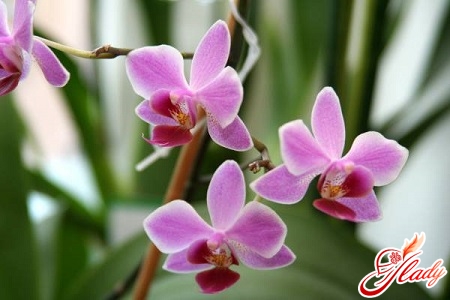
Humidity and temperature
Popular types of orchids in the homeIt is also necessary to ensure the correct range of positive temperatures. In the afternoon, it can range from eighteen to twenty-seven degrees, and at night must be between thirteen and twenty-four. Small deviations from this temperature regime are usually well tolerated by these plants, but it is not necessary to neglect them unnecessarily. And once again I would like to remind you that in a hot period it is necessary to increase watering, and to cool down, on the contrary, to reduce. Orchids, which should be planted in pots or baskets for cultivation outside the natural environment, need a certain temperature difference in the light and dark time, since this difference depends on the flowering of exotics. Therefore, if your tropical beauty is accustomed to heat and therefore does not release buds for a long time, then try to stimulate this process by moving it to a cooler place for the night. As for humidity, it should be within sixty to eighty percent, which in principle is an optimal indicator for the human body. If the air in the room is too dry, place the orchid pots on a special pan with a grill on the bottom of which there is water, and on top lies a layer of gravel. Make sure that the bottoms of the containers with flowers touch only the drainage layer. In hot days, spray plants from the spray gun - do it better in the morning and in the afternoon, so that until nightfall the orchid has time to dry out. Care for these exotic plants in pots provides for a constant influx of fresh air, but one must remember that drafts are contraindicated to them. If the room is not well ventilated, then it can be simulated with a domestic cooling air heater of low power. But in this case, moisture will evaporate faster from the atmosphere, so you need to increase the frequency of watering. Proper care for indoor orchids is impossible without additional fertilizing with fertilizers. You can easily buy them in a garden center or a specialized store. Using such formulations, it is necessary to follow the recommendations on the standards indicated on the labels. The general advice for feeding all orchids is a large frequency during growth and flowering, and less if the plant is at rest in the cold season. About the need to transplant an orchid is most often indicated by a too obvious difference between its green part and the width of the pot. Do not rush to do this if the root system just acts on the vase, which is considered quite normal. Orchid should be planted in a new container with fresh substrate after the flowering period is over. It is important to remove the plant from the old pot so that it does not damage the root system during extraction. Sometimes this requires cutting plastic. Carefully inspect the bottom of the flower and remove all dry and decayed roots. Then place the orchid in a larger pot with a small layer of substrate and pour the roots on top. Remember that the point of growth of exotics does not need to be covered with soil, it should be just below the sides of the vase. After completing the transplant, the soil should be moistened and put the pot of the orchid in a shaded place for a couple of days. 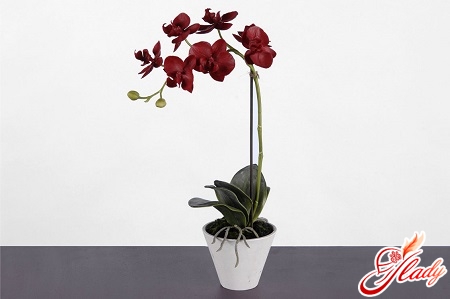
We choose pots and soil for orchids
And now it is necessary to say a few words about how,how to choose the right container for orchids and ground mixtures. The main task that the pots and substrate perform is the maintenance of the epiphytic orchid in an upright position, the preservation of the necessary amount of moisture at its roots, and the provision of fresh air. Therefore, the soil practically never contains land. The plant is recommended to plant in a substrate of bark, coal, special clay, moss and coarse sand. Some other variations are possible. Pots for orchid-epiphytes can serve as wicker baskets or pots of wire. This exotic flower should be planted in any container that holds so specific a primer and is well ventilated. Ground species of orchids require supplementing the basic composition of the substrate with dry leaves and garden soil, which allow better preservation of moisture in intervals between watering. Most plants are advised to plant in plastic transparent pots that have a number of holes to remove excess water. To cheap capacities do not spoil the general aesthetics with their unsightly appearance, you can hide them in beautiful spacious pots. If you are just beginning to breed or collect orchids, it is better to use ready-made substrates and soil mixtures that are sufficiently represented in any flower shop specializing in the sale of these plants. You should not be confused by the inscription on the package, indicating the specific name of the orchid. So, soil mixture with the mark "for phalaenopsis" is also excellent for other epiphytes, and if the label is "for tsimbidiuma", it is allowed to plant terrestrial plant species. Adhere to the basic tips for choosing pots and grounds for your exotic beauties, and also follow the necessary recommendations for caring for plants. It is from the totality of all these factors that the duration of their life cycle and normal development depends. If you do not have the experience that will allow you to provide an orchid with proper care, consult the place where it was purchased about how and where the flower should be planted, how often to water it, and so on. In the future, you can easily master the role of the owner of such exotics, and the plant itself will please you with an unusual beauty and grace. We advise you to read:




